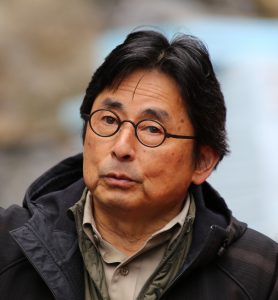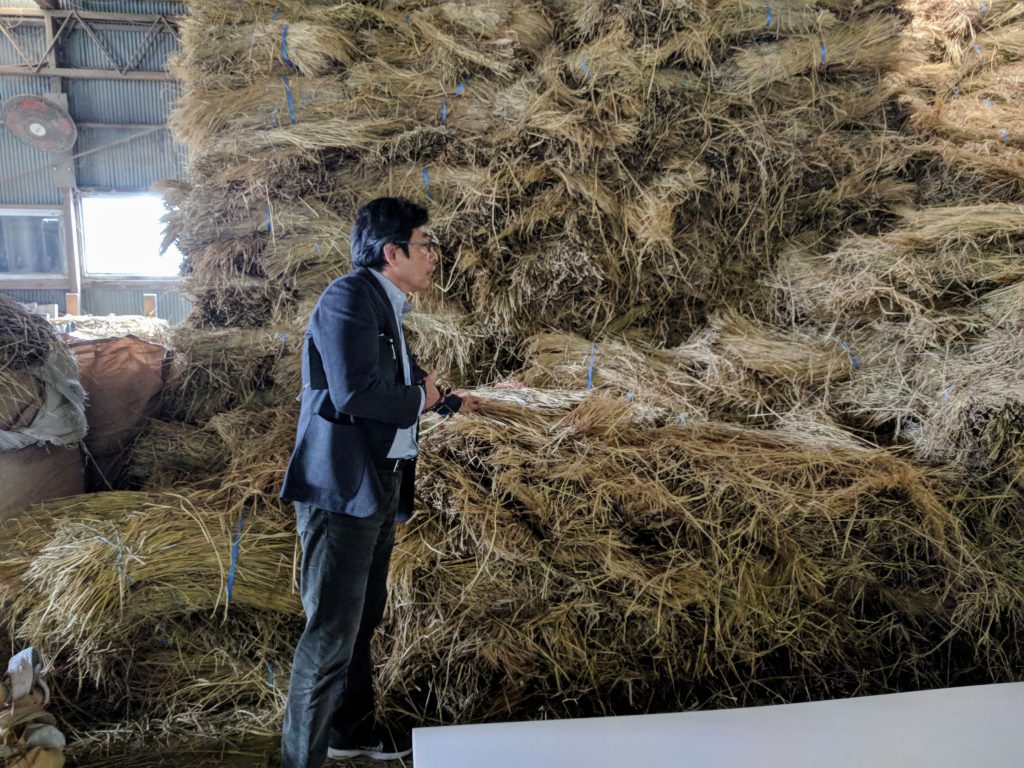In Pursuit of a New Form of Tatami Together with a Landscape Architect Sadafumi Uchiyama (garden curator at Portland Japanese Garden, Oregon, USA) Part 1 of 3

Sadafumi Uchiyama – landscaper, gardener & garden curator at Portland Japanese Garden
Born 1955 in Fukuoka Prefecture, Kyushu Island, Japan, his family had been professional gardeners since the early 1900s, allowing him to study professional techniques from an early age. After participating in developmental cooperation projects in Tanzania and Yemen, he moved to the USA in 1988, gaining a degree and masters in landscape architecture from the University of Illinois, allowing him to combine aspects of Japanese gardening techniques with western landscape architecture principles. Active in a wide variety of private and public landscape projects, his representative achievements include gardens at Jackson Park, Chicago, Denver Botanic Gardens, Colorado & the Duke University, North Carolina. He is one of the founders of the North American Japanese Garden Association (NAJGA). Since 2010 he has been active all over America, working on private properties and commercial facilities, sometimes in collaboration with the famed Japanese architect Kengo Kuma. His publishing and speaking activities are centered in the USA, and he also teaches landscape design and practical application in universities and public Japanese gardens. In 2018 he was awarded the Garden Society of Japan Prize at the 100th anniversary celebrations of the Garden Society of Japan.
In Pursuit of a New Form of Tatami Together with a Landscape Architect
Sadafumi Uchiyama (garden curator at Portland Japanese Garden, Oregon, USA)
Modern day society tends to prioritize the elimination of natural world elements in favor of a safe living environment. We enlisted the help of renowned gardening expert and landscape architect Sadafumi Uchiyama to look into the creation of a living space that is both beautiful and pleasing through the use of nature, particularly straw tatami matting. Explore with us the tradition and beauty of the XT tatami experience.

The Garden – A job that takes both time and effort
I have, basically, two jobs. One is managing the Japanese garden in Portland as its curator, and the other is working as a landscape architect. One thing that landscaping has in common with making objects is that the creator always feels the need to create, which is one of the reasons that in addition to curating the Portland garden I also take on other jobs, designing gardens of many different kinds, for private individuals all over the US and also for public facilities. I always take the gardens I design to fruition, doing everything myself, so there’s no way I would design a garden that I couldn’t build myself. It’s easy to just say “build a garden” and it starts with just putting things in place, but it can take tens of years to bring it to completion, so I would say my job really does take time and effort.
Getting back into Japanese gardens after a long journey
Leaving the family home for Tanzania and Yemen
Artisans are people who have been trained to make things. I was born in a family of professional gardeners, and used to help out with the family business from an early age. By the time I was 10, I didn’t even have Sundays off, and at around 18 I realized that I had unwittingly received training to a professional level, which was pretty astounding! (laughs) However, I had a strong urge to spend some time away from the family business, so at 22 I joined the JICA volunteers and spent 3 years in Tanzania. What I learned there was that death is scarier than anything else around. That’s how dangerous it was in terms of both law & order and health & hygiene. I caught malaria 4 or 5 times, which gave me several brushes with death. I wanted to stay longer, but ended up going back to Japan for health reasons, but even after all that, I was a glutton for punishment and continued working with JICA for another 2 years in Yemen. That’s where I learned that you shouldn’t be constrained by preconceptions. I discovered that my own preconceptions made me look at things through a Japanese lens, and out of that I was able to learn determination. I also learned that misunderstandings can be their own particular kind of knowledge. So, living in a different culture from my own removed preconceptions from my mindset. Ever since then, if I ran into something radically different, I didn’t approach it from my own mindset, thinking “Why isn’t it like this?” but tried to understand it from the other point of view, thinking “What made it like this?” Now that I think about it, it was my time in Tanzania and Yemen that taught me how to think like that. I guess those 5 years really knocked me into shape. (laughs)
This was also a time when I started to take a fresh look at jobs related, in a wide sense, with nature, such as landscaping and tree-planting & greening, since for those 5 years I had seen so many wastelands where all the trees had been cut down for firewood. My experience of large-scale greening in those two countries engendered in me a desire to work on a really big garden area like Central Park, so I decided to study landscape architecture in America.
My time in the USA, reassessing Japan from afar
I arrived in America a blank slate, everything that I had absorbed in Japan nullified by my experiences in Tanzania and Yemen. And the world that waited for me there was one of extreme communication. Lectures in American universities are geared towards Q & A and debate, so communicative ability is a must. I was able to make and build things, but couldn’t explain it using words. For example, if you said to me “Lay those stones,” I could do it in an instant, but if you said “Why did you lay them like that?” I just couldn’t answer. Everything I had done up till then was based on practical experience, so I was forced to inspect everything I had learned practically, analyze it and practice how to express it all verbally. One thing I did notice while doing this was that the contents of my experience included the history and tradition of Japanese gardens. I wasn’t ignorant. It was all there inside my head, but I just didn’t know how to access it.
It’s really easy to just say “It can’t be explained in words,” or “I can’t say it exactly,” but I think there are many things like that that should be talked about, so we should never give up trying to put them into words and conveying them to other people. Expressing things like this verbally is an important part of what I do, and will probably continue until I die. The act of expressing Japanese things and their cultural background verbally to people who don’t share the same mindset, or translating these ideas into something they can understand, in some ways is equivalent to reassessing Japanese culture while being geographically far removed from it.
While I was in America, there was another thing that changed my way of thinking. At the University of Illinois, I studied cultural geography, which looks at geography from a cultural aspect. It’s an academic field which specializes in the background and process of how landscapes are formed under cultural influences. During that time, I discovered D.W. Meinig’s “The Beholding Eye: Ten Versions of the Same Scene,” a short essay. Gardens are usually viewed only as arts, crafts or part of the dwelling environment, but this essay took a wider approach to landscaping, stating that “Landscaping is art, politics, economics, society, an ecosystem…” That made me aware that I myself had always had an overly narrow view of what landscaping entailed, and it really brought me to a surprisingly more progressive and open view of gardening and landscaping. For example, some people may look at the Portland Japanese Garden and think, “An example of Oriental beauty and rarity,” appreciating its cultural and beautiful aspects, whereas others may look at it from the point of view of investment and monetary ideas, thinking “What financial value has it returned in its 55 years?” And both of those are valid. Ever since then, my idea of a Japanese garden became something different to what it originally was. I was descended from a long line of professional gardeners, but I guess you could say that my perceptions of what a Japanese garden was changed in America.
I think if I have even the slightest ability to look at things objectively, it’s because it’s not so much an inborn ability, as using my various experiences as a basis to discard the things I can’t use when I look at things. I got rid of preconceived ideas and being bound by convention. I may have discarded lots of things, but there also plenty of ideas that are left, and those become strengths. That’s what makes the basis of what I am now.